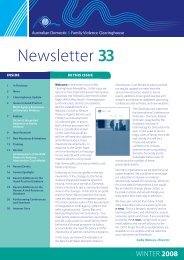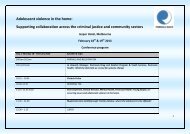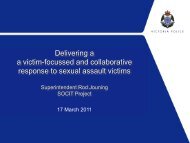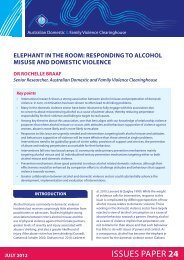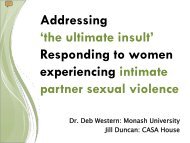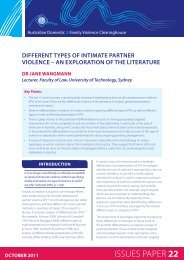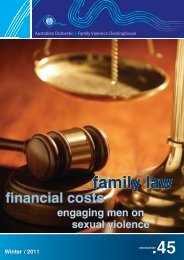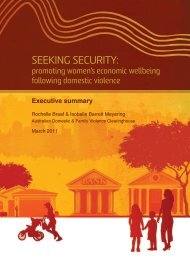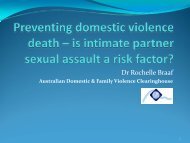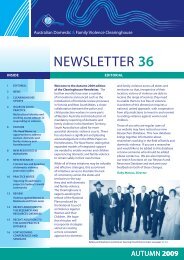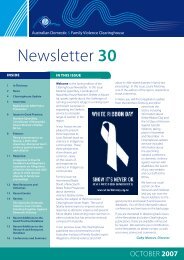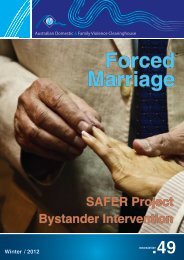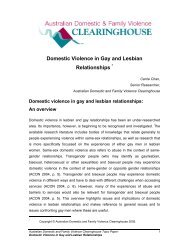Violence through our eyes - Women With Disabilities Australia
Violence through our eyes - Women With Disabilities Australia
Violence through our eyes - Women With Disabilities Australia
You also want an ePaper? Increase the reach of your titles
YUMPU automatically turns print PDFs into web optimized ePapers that Google loves.
• an overall increase in the use of family members and other relatives as interpreters,<br />
a clear violation of Standard 4 of the Disability Services Standards.<br />
Financial Vulnerability<br />
In general, people from NESB with disability are lower on the socio-economic scale<br />
compared to their Anglo-<strong>Australia</strong>n counterparts. This is often explained by:<br />
• level and recognition of educational qualifications;<br />
• level and recognition of work skills and experience; and<br />
• level of English language proficiency.<br />
In <strong>Australia</strong> all migrants (except those immigrating on humanitarian grounds) have<br />
to wait two years before they can access income support. Migrants with disability,<br />
however, including their carers, have to wait ten years to be eligible for any<br />
income support, such as Disability Support Pension or Carers Pension. In<br />
addition, those who are eligible for pensions, other support payments or services<br />
are frequently not aware of their entitlements because successive Government<br />
information strategies have failed to communicate new initiatives and programs to<br />
people with low English proficiency.<br />
Carer/Family ‘Burn Out’<br />
In general, carers from NESB only seek help when they reach crisis.<br />
Responsibilities carried by families and carers from NESB are excessive and<br />
families may experience multiple layers of disadvantage – disability, poverty,<br />
disruption to the family as a result of migration, diminished support networks and<br />
lack of sufficient and appropriate services. Asking for support is also seen as<br />
failing the family, the community and, most importantly, the person they are caring<br />
for.<br />
2. Specific issues for women with disability/carers experiencing<br />
violence<br />
Cultural factors<br />
Responses to disability vary enormously among individuals and groups within any<br />
community. Some attitudes and beliefs are also common in many communities,<br />
including the Anglo-<strong>Australia</strong>n community.<br />
When considering the issue of violence against women from NESB, cultural<br />
values and religious beliefs can work against the recognition of violence. If the<br />
beliefs and practices of a community devalue women and confine them to<br />
stereotyped roles, women may be more vulnerable to violence because, as part of<br />
the community, they may accept violence as an inevitable aspect of a woman’s life<br />
experience.<br />
When experiencing violence, it is difficult for women from NESB to seek assistance<br />
because of:<br />
• language difficulties;<br />
• family loyalty;<br />
• fear of being cut off from family and ostracised by the community;<br />
<strong>Violence</strong> <strong>through</strong> <strong>our</strong> <strong>eyes</strong> 23



